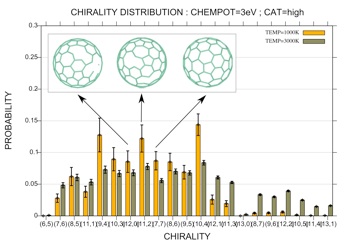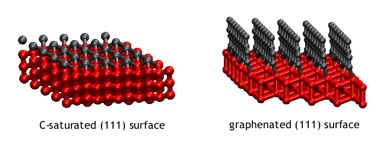Understanding and Controlling Chirality

We are using statistical methods to study ensembles of caps that form under a prescribed growth environments. This provides us a systematic manner in which to control growth parameters such as temperature, precursor pressure, carbon - catalyst interaction strength, and catalyst size. Our approach is based on grand canonical Monte Carlo simulations which utilize parameters extracted from ab initio simulations to describe the atomic interactions that take place. Using this statistical approach, we predict how chirality distributions vary under different growth environments, with the ultimate aim of learning how to tailor chirality-specific growth processes.
The Role of Facets in Nanotube Growth

To explain these observations, we have explored via density functional theory the surface energies of BCC iron under different surface terminations (for instance, surfaces terminated with isolated carbon atoms and surfaces terminated with graphene layers, as illustrated in the figure below). Our predictions of the Wulff shape of the iron catalyst correspond nicely with experimental observations.
Nanotube Growth

Massachusetts Institute of Technology, 77 Massachusetts Avenue, Cambridge MA 02139-4307

